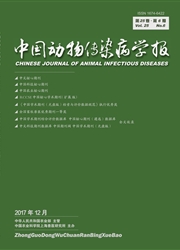

 中文摘要:
中文摘要:
将35头40日龄猪繁殖与呼吸综合征病毒(Porcine reproductive and respiratory syndrome virus,PRRSV)、猪瘟病毒(Classical swine fever virus,CSFV)、猪圆环病毒(Porcine circovirus type 2,PCV2)抗原及抗体均为阴性的健康仔猪,随机分成7组,每组5头,命名为XJ1~XJ7组。XJ1~XJ6组分别免疫PRRSV基因工程双标记疫苗rHN4-△25+NP49株,接种剂量分别为102TCID50/头、103TCID50/头、104TCID50/头、105TCID50/头、106TCID50/头和107TCID50/头,XJ7组为对照组,按1mL/头剂量接种DMEM。各试验组在免疫后28 d,用3×104.0TCID50/头剂量感染HP-PRRSV HuN4第5代强毒,疫苗免疫和攻毒后观察和检测各组试验猪的免疫效果。结果表明:攻毒前XJ2-XJ6组PRRSV ELISA抗体在免疫后14 d全部转为阳性,XJ1组在免疫后21 d转为阳性,但维持在较低水平;XJ2-XJ6组针对标记基因NP49的特异性抗体在免疫后28 d转阳性。攻毒后对照组全部发病,且死亡2头,XJ1有4头发病,XJ2-XJ6组无发病和死亡,本研究结果表明PRRSV基因工程双标记疫苗rHN4-△25+NP49株对仔猪提供免疫保护的最小免疫剂量为103TCID50/头。
 英文摘要:
英文摘要:
Thirty five 40-days old piglets without Porcine reproductive and respiratory syndrome virus (PRRSV), Porcine circovirus (PCV2) and Classical swine fever virus (CSFV) were selected and randomly divided into 7 groups (XJ1-XJ7). Each of piglets in groups XJ1-XJ6 was inoculated with 102TCID50 to 107TCID50 of HP-PRRS dual-marker vaccine rHN4-Δ25+NP49 strain, respectively. Group XJ7 served as infection control. On 28 day post immunization, all animal were infected with 3×104TCID50 HuN4-F5 strain. Fever and other clinical signs were recorded daily. Pigs in group XJ2-XJ6 developed high level of humoral response against PRRSV from day 14 post immunization while piglets in group XJ1 developed a low level PRRSV antibody response from day 21 post immunization. Four piglets in group XJ1 and 5 piglets in XJ7 had various disease manifestations, including persistently high fever and anorexia. Two piglets in group XJ7 died at days 5 and 20 post challenge. On the contrast, piglets in groups XJ2-XJ6 did not show any clinical signs post challenge. These results indicated that the minimum immunization dose of rHN4-Δ25+NP49 strain was 103TCID50, which conferred effective protection against HP-PRRSV.
 同期刊论文项目
同期刊论文项目
 同项目期刊论文
同项目期刊论文
 Identification of differentially expressed proteins in porcine alveolar macrophages infected with vi
Identification of differentially expressed proteins in porcine alveolar macrophages infected with vi Development of monoclonal antibodies specifically recognizing the endogenous sterile alpha motif and
Development of monoclonal antibodies specifically recognizing the endogenous sterile alpha motif and 期刊信息
期刊信息
